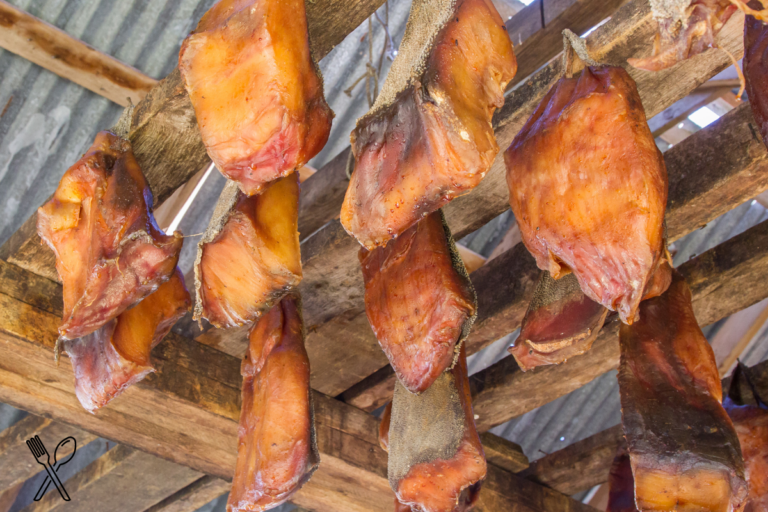Fermented Shark Dish – Iceland, a country renowned for its scenery and rooted traditions, presents a culinary journey, like no other through its classic delicacy hákarl. This fermented shark dish, famous for its aroma and robust flavor, holds a fascinating history and an exceptional method of preparation that showcases the resilience and creativity of the Icelandic people.
The Tale Behind Hákarl
The origins of hákarl trace to the era of the Vikings, a time when Iceland’s early inhabitants had to adapt to survive the harsh Nordic environment. Greenland sharks, found in the North Atlantic waters surrounding Iceland, served as a food source. Nevertheless, their flesh is poisonous when fresh due to levels of dimethylamine oxide. To address this challenge, the Vikings devised a technique involving fermentation and drying of the meat to remove toxins and render it safe for consumption.
This method played a role in survival during prolonged winters when fresh sustenance was scarce. Throughout generations, the preparation process, for hákarl has endured with changes safeguarding this aspect of Icelandic culinary tradition.
The Crafting Procedure Hákarl – Fermented Shark Dish
Crafting hákarl demands precision and patience as it undergoes phases of fermentation and drying.
Here’s a detailed guide, on how to prepare this dish:
Ingredients and Tools
- Greenland shark (Somniosus microcephalus): Either freshly caught or sourced.
- Gravelly ground: Used for burying shark meat.
- Heavy rocks: Needed for pressing the meat down.
- Drying rack or open shed: Essential for drying out the meat.
Step-by-Step Instructions
1 – Initial Cleaning:
Remove the innards and head of the shark. Cut it into pieces around 2 to 3 feet in length.
2 – Fermentation:
Create a pit in an area with soil, making sure it’s deep enough to hold the shark pieces and allow drainage.
Place the shark pieces in the pit, cover them with sand and put rocks on top. This pressure helps drain fluids and kickstarts fermentation.
Let the shark ferment for 6 to 12 weeks, adjusting based on weather conditions.
3 – Drying:
Once fermentation is complete, take out the shark meat from the pit. It will have a smell and slimy feel.
Slice the meat into strips and hang them in an open shed or drying rack, with good air circulation, shielded from rain and direct sunlight.
Dry out the meat for 4 to 5 months until it reaches a texture with a distinct flavor.
Final Step of Preparation:
Slice the dried shark meat into bite portions and let them age for a few additional weeks in a cool, dry location.
Presentation:
Keep the hákarl in sealed containers to preserve its taste. Serve in cubes or slices, often paired with a shot of brennivín an Icelandic schnapps.
The Cultural Importance of Hákarl
Hákarl goes beyond being a dish; it embodies Iceland’s significance and cultural strength. Traditionally enjoyed during Þorrablót, a winter festival honoring the Norse god Þorri hákarl is part of a feast featuring preserved foods. This celebration, observed between January and February, links Icelanders to their customs. Highlights the adaptability needed to thrive in their harsh surroundings.
In contemporary Iceland, hákarl is seen as more of a treat than an everyday meal. It is often offered to visitors as an adventure that gives them a taste of genuine Icelandic heritage. Despite its aroma and flavor, hákarl remains a source of pride, for Icelanders, symbolizing their resilience in one of the world’s demanding environments.
Closing Thoughts
Hákarl serves as proof of the creativity and resilience of the population.
Crafting this dish involves blending age methods, with customs, creating a meal that is not only special but also holds significant value. Delving into the world of food by sampling hákarl provides a captivating insight into the country’s past and enduring character.
What Next:
- Crocodile Ice Cream: A Wild Adventure in Dessert-Making
- Pasta Carbonara- A Classic Italian Delight
- Japanese Miso Glazed Salmon – A Delicious Taste and Health
- Feijoada – A Taste of Brazil
- Bouillabaisse – The Legendary Fish Stew, from Marseille


